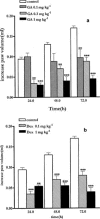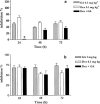Geldanamycin, an inhibitor of heat shock protein 90 (Hsp90) mediated signal transduction has anti-inflammatory effects and interacts with glucocorticoid receptor in vivo
- PMID: 10960063
- PMCID: PMC1572305
- DOI: 10.1038/sj.bjp.0703549
Geldanamycin, an inhibitor of heat shock protein 90 (Hsp90) mediated signal transduction has anti-inflammatory effects and interacts with glucocorticoid receptor in vivo
Abstract
Histamine, vascular endothelial growth factor, acetylcholine, oestrogen as well as fluid shear stress activates a mechanism that recruits heat shock protein 90 to the endothelial nitric oxide synthase. The interaction between Hsp90 and eNOS enhances the activation of the enzyme in cells and in intact blood vessels leading to NO production. Intraplantar administration of carrageenan (50 microl paw(-1)) to mice causes an oedema lasting 72 h. Geldanamycin (0.1, 0.3, 1 mg kg(-1)), a specific inhibitor of Hsp-90, that inhibits endothelium-dependent relaxations of the rat aorta, mesentery and middle artery inhibits carrageenan-induced mouse paw oedema in a dose dependent manner. Co-administration to mice of dexamethasone (1 mg kg(-1)) with geldanamycin (0.3 mg kg(-1)) at anti-inflammatory dose causes a loss of the total anti-inflammatory effect of each agent alone. RU 486 (10 mg kg(-1)), a well known glucocorticoid receptorial antagonist, does not inhibit oedema formation but prevents the anti-inflammatory action of dexamethasone (1 mg kg(-1)). Similarly, RU 486 prevents the anti-inflammatory action of geldanamycin (0.3 mg kg(-1)). In conclusion we have described for the first time that geldanamycin, an inhibitor of Hsp90 dependent signal transduction, is anti-inflammatory in vivo implying that Hsp90 is critical for pathways involved in carrageenan-induced paw oedema. In addition the ability of GA to block NO release and reduce oedema formation suggests a therapeutic rationale for specific inhibitors of Hsp90 as potential anti-inflammatory drugs.
Figures



Similar articles
-
Stable and specific binding of heat shock protein 90 by geldanamycin disrupts glucocorticoid receptor function in intact cells.Mol Endocrinol. 1996 Jun;10(6):705-12. doi: 10.1210/mend.10.6.8776730. Mol Endocrinol. 1996. PMID: 8776730
-
Dynamic activation of endothelial nitric oxide synthase by Hsp90.Nature. 1998 Apr 23;392(6678):821-4. doi: 10.1038/33934. Nature. 1998. PMID: 9580552
-
Geldanamycin, a heat shock protein 90-binding benzoquinone ansamycin, inhibits steroid-dependent translocation of the glucocorticoid receptor from the cytoplasm to the nucleus.Biochemistry. 1997 Jun 24;36(25):7776-85. doi: 10.1021/bi970648x. Biochemistry. 1997. PMID: 9201920
-
Hsp-90-associated oncoproteins: multiple targets of geldanamycin and its analogs.Leukemia. 2002 Apr;16(4):455-62. doi: 10.1038/sj.leu.2402415. Leukemia. 2002. PMID: 11960322 Review.
-
Chaperoning oncogenes: Hsp90 as a target of geldanamycin.Handb Exp Pharmacol. 2006;(172):259-77. doi: 10.1007/3-540-29717-0_11. Handb Exp Pharmacol. 2006. PMID: 16610363 Review.
Cited by
-
Targeting HSP90 Inhibits Proliferation and Induces Apoptosis Through AKT1/ERK Pathway in Lung Cancer.Front Pharmacol. 2022 Jan 14;12:724192. doi: 10.3389/fphar.2021.724192. eCollection 2021. Front Pharmacol. 2022. PMID: 35095481 Free PMC article.
-
Antifungal activity of geldanamycin alone or in combination with fluconazole against Candida species.Mycopathologia. 2013 Apr;175(3-4):273-9. doi: 10.1007/s11046-012-9612-1. Epub 2013 Jan 23. Mycopathologia. 2013. PMID: 23341047
-
Geldanamycin treatment does not result in anti-cancer activity in a preclinical model of orthotopic mesothelioma.PLoS One. 2023 May 5;18(5):e0274364. doi: 10.1371/journal.pone.0274364. eCollection 2023. PLoS One. 2023. PMID: 37146029 Free PMC article.
-
Nitric oxide suppresses LPS-induced inflammation in a mouse asthma model by attenuating the interaction of IKK and Hsp90.Exp Biol Med (Maywood). 2015 Apr;240(4):498-507. doi: 10.1177/1535370214554880. Epub 2014 Dec 16. Exp Biol Med (Maywood). 2015. PMID: 25519430 Free PMC article.
-
Increased superoxide generation and decreased stress protein Hsp90 expression in human umbilical cord vein endothelial cells (HUVECs) from pregnancies complicated by preeclampsia.Hypertens Pregnancy. 2006;25(3):169-82. doi: 10.1080/10641950600912950. Hypertens Pregnancy. 2006. PMID: 17065038 Free PMC article.
References
-
- BRESNICK E.H., DALMAN F.C., SANCHEZ E.R., PRATT W.B. Evidence that the 90 kDa heat shock protein is necessary for the steroid binding conformation of the L cell glucocorticoid receptor. J. Biol. Chem. 1989;264:4992–4997. - PubMed
-
- CALHOUN W., CHANG J., CARLSON R.P. Effect of selected antiinflammatory agents and other drugs on zymosan, arachidonic acid, PAF and carrageenan induced paw edema in the mouse. Agent Actions. 1987;21:306–309. - PubMed
-
- DALMAN F.C., BRESNICK E.H., PATEL P.D., PERDEW G.H., WATSON S.J.J., PRATT W.B. Direct evidence that the glucocorticoid receptor binds to Hsp90 at or near the termination of receptor translation in vitro. J. Biol. Chem. 1989;264:19815–19821. - PubMed
-
- GARCIA-CARDEÑA G., FAN R., SHAH V., SORRENTINO R., CIRINO G., PAPAPETROPOULOS A., SESSA W.C. Dynamic activation of endothelial nitric oxide synthase by Hsp90. Nature. 1998;392:821–824. - PubMed
-
- GRONEMEYER H., LAUDET V. Transcription factors 3: nuclear receptors. Protein Profile. 1995;2:1173–1308. - PubMed
MeSH terms
Substances
LinkOut - more resources
Full Text Sources
Other Literature Sources

